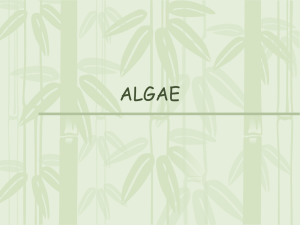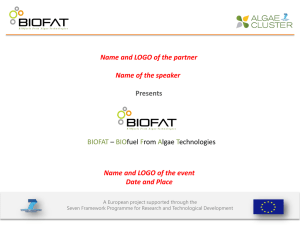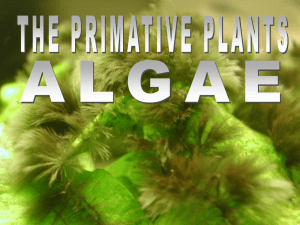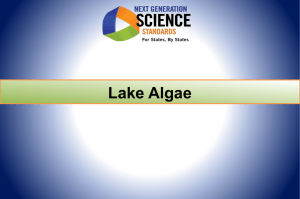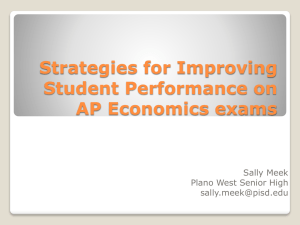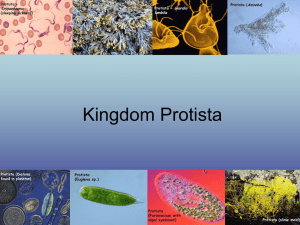Nefdt_T - Energy Postgraduate Conference
advertisement
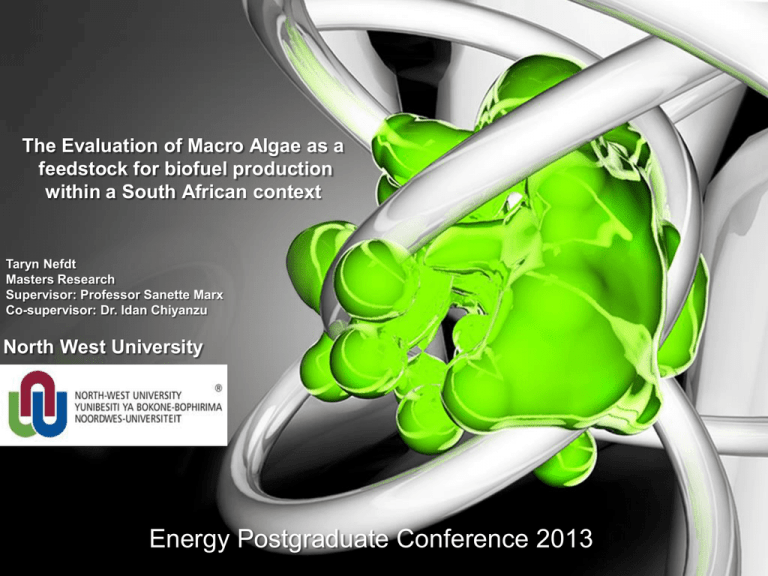
The Evaluation of Macro Algae as a feedstock for biofuel production within a South African context Taryn Nefdt Masters Research Supervisor: Professor Sanette Marx Co-supervisor: Dr. Idan Chiyanzu North West University Energy Postgraduate Conference 2013 Presentation Outline • Introduction • Objectives • Experimental Setup • Data Analysis • Value Added Products • Conclusion • References Introduction • Fossil fuels are currently being utilized for the world’s energy needs. • A dilemma therefore exists, since fossil fuels are a non-renewable resource. The use of fossil fuels is also not sustainable in terms of the resultant increase in greenhouse gas emissions. • There are three main fossil fuels utilized globally to satiate the demands of the transport, electricity generation and industrial sectors. Coal • Gas Oil South Africa derives the majority of its energy for electricity generation, from coal. It is estimated that South Africa will exhaust its supply of coal by the year 2050. • In terms of engine fuel for the transport sector, South Africa does not have a large amount of oil reserves and relies mainly on imports to sustain the transport industry. • The Biofuel Industrial Strategy of South Africa, released by the Department Minerals and Energy in 2007 suggested the utilisation of sugar cane and sugar beet for bioethanol production and the utilisation of sunflower, canola, and soya beans for the production of biodiesel. • The strategy showed a preference for first generation feedstocks for bioethanol and bio-oil production at a 2% suggested penetration level. • The purpose of this presentation is to examine my research which evaluates the feasibility of a third generation feedstock: Macro Algae within a South African context. Objectives • To produce sufficient yields of the products bioethanol, biodiesel, and biobutanol. • To examine the efficiency of micro-organisms currently used for fermentation. • To highlight the advantages of Macro Algae as a feedstock over first generation feedstocks and second generation feedstocks. • To integrate data from the current major producers of Macro Algae in the study i.e the Abalone farms. • To produce a Business Intelligence Application that neatly encapsulates the experimental results of this study as well as key economic and feasibility indicators for decision making purposes at government and private stakeholder level. • To subject the Macro Algae extracts to thorough compositional analysis in order to shed light on potential Value Added Products. • To suggest techniques to deal with potential market over saturation. Experimental Setup • The three Macro Algae species chosen for the study are: Ecklonia Maxima, a brown Algae species, Ulva Spp, a green Algae species, and Gracilaria Spp, a red Algae species. • The fresh Macro Algae samples will be dried overnight at 105 ⁰ C until a constant weight is obtained. • The samples will then be milled using a Hammer mill (TRF 70) until they are fit to pass through a 1.5 mm screen and then stored in sealed glass stoppered flasks at room temperature. Green Algae Red Algae Ulva Spp Gracilaria Spp Brown Algae Ecklonia Maxima • The Pre-treatment phase, in order to release the simple sugars from the Macro Algae extracts, needed for subsequent fermentation, will involve Sulphuric Acid Hydrolysis using dilute Sulphuric Acid. • Oxalic Acid will also be used in separate Pre-treatment experiments and comparisons between the two acids in terms of Pre-treatment efficiency will be made. HPLC analysis will be used to quantify the sugars in the hydrolysate. • Batch Fermentation experiments will be carried out using two different micro-organisms in separate fermentation flasks. • The yeast Pichia angophorae (ATCC®22304™) will be used for the ethanol fermentation. • The bacterium Clostridium Acetobutylicum will be used for the acetone butanol fermentation. • These organisms are able to utilize the Macro Algae sugars such as mannitol and laminarin as substrates for fermentation. • The bio-oil for biodiesel production will be produced using liquefaction, and the Macro Algae milled extracts as a feedstock. Data Analysis • The PowerPivot Add-in is integrated into the Excel Software Package and will be used for the Business Intelligence and data storage component of the research. • Data from contemporary literature sources regarding Macro Algae as a feedstock for biofuel production will be used to create a baseline. • Data from this study will be entered into the relational schema and analysed, using standard Excel statistical techniques as well as the Business Intelligence indicators given by the DAX language. • Data from the current Macro Algae producers and suppliers such as the Abalone farms will be integrated. • This data will be used to create a complete Business Intelligence Application that can be accessed by various stakeholders such as policy makers, SMME's interested in biofuel start-ups, and vehicle manufacturers. • A complete Chemical Information System will be created for accurate assessment and economic viability of Macro Algae as a potential feedstock for biofuel production in the South African context. Value Added Products • Part of the appeal of Macro Algae as a biofuel feedstock is that the scientific community and industrial community are familiar with Macro Algae derived products. • Macro Algae extracts, in combination with Propylene Oxide are used to make food-grade thickeners and foam stabilizers. • Macro Algae is used in the production of hydrocolloids. • Macro Algae is also used as feed in the aquaculture industry and in the South African context – as feed in the Abalone industry. • In addition to biofuel production, Macro Algae can also be used in the chemical synthesis industry. HPLC analysis and compositional analysis will be conducted in order to determine useful by-products and intermediates of the fermentation and liquefaction experiments. • These Value Added Products are important to prevent market over saturation of biofuels in the current South African context. Conclusion • Macro Algae could be used as a feedstock for bio-energy production in South Africa. However, there are a number of key issues to take into consideration: • Adaptive Capacity of Abalone Farms with regards to Biofuel production. • The current supply to market chain for Macro Algae. • Optimization of the bioprocessing techniques for the production of biofuel • BRICS partnership agreements for bioethanol exports. • Value Added Products to offset production costs. • The attitudes of industry and SMME incentives. • Government policy and regulation. • The implementation of FFV vehicles in South Africa for bioethanol use for blend E85. References • PowerPivot for Excel. (2013). Retrieved May 12, 2013, from Microsoft Developer Network: http://msdn.microsoft.com/en-us/library/ee210644.aspx • Bolton, J., Anderson, R., Shuuluka, D., & Kandjengo, L. (2008). Growing Ulva (Chlorophyta) in integrated systems as a commercial crop for Abalone feed in South Africa: a SWOT analysis. Journal of Applied Phycology, 575-583. • Energy, D. o. (2003). White Paper on the Renewable Policy of the Republic of South Africa. • Energy, D. o. (2007). Biofuels Industrial Strategy of the Republic of South Africa. Department of Minerals and Energy. • Pegels, A. (2010). Renewable Energy in South Africa: Potentials, barriers and options for support. Energy Policy, 4945-4954. • Roesijadi, G., Jones, S. B., Snowden-Swan, L. J., & Zhu, Y. (2010). Macroalgae as a Biomass Feedstock: A Preliminary Analysis. United States Department of Energy. • StatsSA. (2005). Natural resource accounts. Statistics South Africa.
